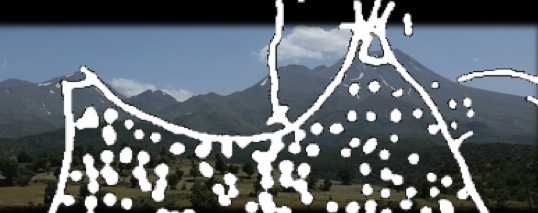Oldest Volcano Painting Linked to Ancient Eruption

DENVER — A 9,000-year-old painting of an exploding volcano, the oldest ever found, can now be linked to a real-life eruption in Turkey.
The towering Hasan Dağ volcano erupted 8,970 years ago, plus or minus 640 years, according to a new dating technique that analyzes zircon crystals in volcanic rock, geochemist Axel Schmitt of the University of California, Los Angeles, reported here today (Oct. 30) at the Geological Society of America's annual meeting.
Turkish scientists long suspected Hasan Dağ was the source of the painting's dramatic scene, but never had a precise date for its volcanic rocks, Schmitt told LiveScience. The volcano is about 80 miles (130 kilometers) from the ancient village of Çatalhöyük, where the painting was discovered in 1964 during an archaeological dig. [The 7 Most Mysterious Archaeological Discoveries on Earth]
"The volcanological evidence also supports what previous interpreters have said about the volcanic style of the eruption here," Schmitt said. "It wasn't a Mount St. Helens-type cataclysmic event. It was small and local, more like a little burp of the volcano."
Schmitt and his colleagues dated volcanic pumice (lava that cooled so quickly it's glass) from the sides and top of Hasan Dağ. Only pumice from the volcano's peak was 9,000 years old, they discovered. Rocks lower down were about 29,000 years old. This means the eruption wasn't big enough to spew lava and ash across the lower slopes.
"If anything, it was a relatively small event, like a Strombolian-type eruption," Schmitt said, referring to the small but spectacular lava fountains that frequently burst from Mount Etna and Mount Stromboli in Italy.
Çatalhöyük was a proto-urban village settled during the Neolithic, or Stone Age. It is the largest and best-preserved Neolithic city ever found. The mural was painted in red-colored ochre on the wall of a shrine, showing what appears to be a map of the settlement and the double peaks of Hasan Dağ.
Get the world’s most fascinating discoveries delivered straight to your inbox.
Since its discovery, the painting has been preserved in a museum and Çatalhöyük has become a popular tourist site. The evidence for a volcanic eruption has also been offered as proof that Hasan Dağ is an active volcano.
Schmitt and his colleagues are conducting further studies to date the past eruption histories of Turkey's many volcanoes, and help better understand the risk of future eruptions.
"Some of these stratovolcanoes have probably had fairly large eruptions," Schmitt said. "They clearly need better constraints about their recurrence."
Email Becky Oskin or follow her @beckyoskin. Follow us @livescience, Facebook & Google+. Original article on LiveScience.





